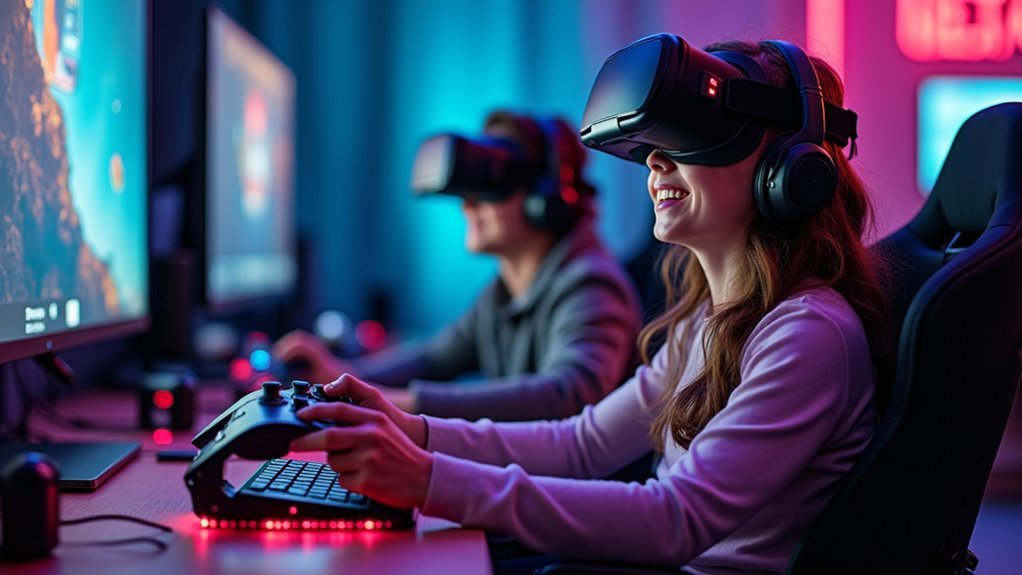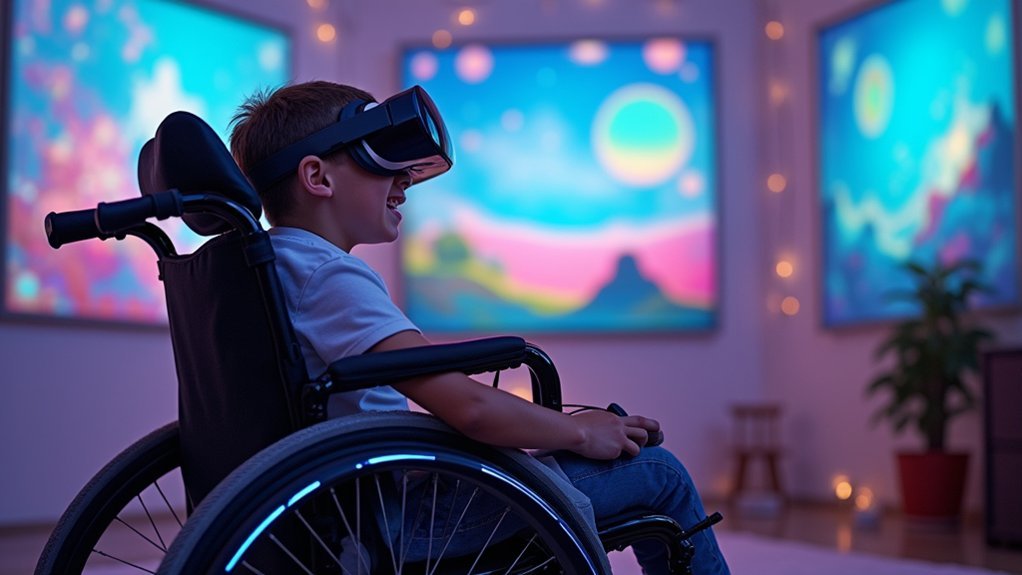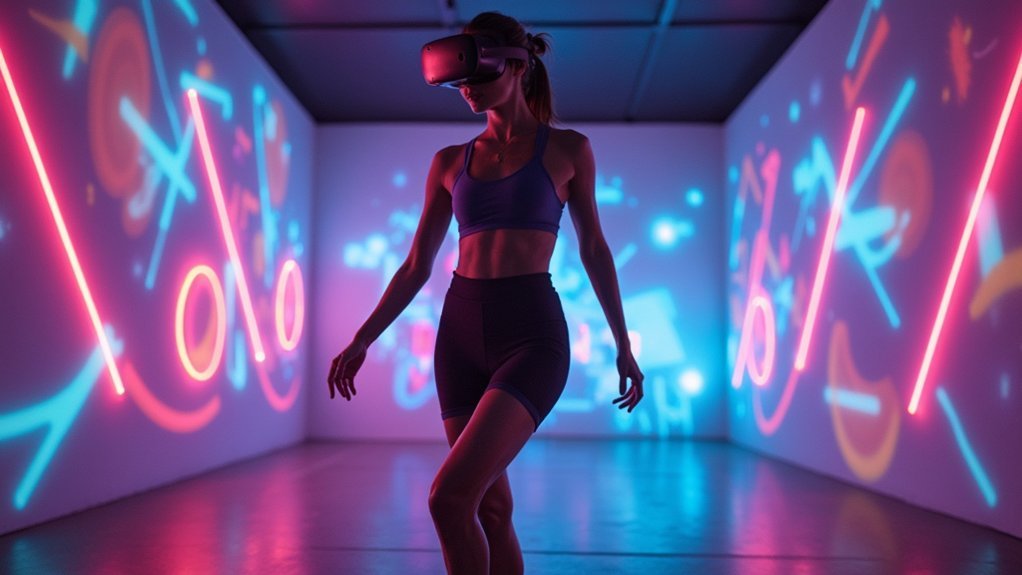You can experience full VR gaming despite mobility limitations through specialized software like WalkinVR Driver, which eliminates physical movement requirements with features like “space drag” navigation. MotionBlocks from the University of Waterloo lets you remap controls using simple shapes that match your range of motion. These adaptive systems include hand tracking for gripping difficulties and Xbox controller integration for collaborative play. Testing shows increased enjoyment and reduced fatigue among users. Discover how these technologies transform virtual worlds into accessible gaming experiences.
WalkinVR Driver Features and Capabilities

Several innovative features make WalkinVR Driver a powerful accessibility tool for VR gaming.
You’ll find virtual movement capabilities that eliminate the need for physical displacement, allowing you to navigate VR games without moving your body. The “space drag” feature works with limited mobility, letting you move through virtual environments using minimal physical motion.
WalkinVR’s controller emulation supports Xbox controller integration, enabling assistants to help manage VR controller inputs when you need support.
Hand tracking technology addresses gripping difficulties by using external sensors to emulate motion controller positions.
This accessibility software adapts to popular VR games across various hardware platforms, creating truly inclusive gaming experiences.
You can enjoy immersive VR regardless of mobility limitations through these extensive features.
MotionBlocks Research and Development
While commercial solutions like WalkinVR Driver offer immediate accessibility benefits, academic research continues pushing the boundaries of VR motion adaptation.
MotionBlocks, developed at the University of Waterloo, represents groundbreaking accessibility research for individuals with limited mobility. This innovative tool lets you remap controls in 3D space using simple shapes that represent your actual range of motion, creating truly customizable VR experiences.
The development involved three research phases, beginning with feedback from 10 participants who shared their VR gaming frustrations. You’ll find that MotionBlocks translates your available movements into required game actions, accommodating your specific capabilities.
Testing with eight participants showed increased enjoyment and reduced fatigue during gameplay. Though not commercially planned, this proof-of-concept demonstrates how motion accessibility features could integrate into standard VR systems.
Adaptive Controller Systems for Limited Mobility

Beyond research prototypes, adaptive controller systems are transforming how you can experience VR games with limited mobility.
WalkinVR leads this revolution by creating a customizable interface that accommodates your physical capabilities. You can remap controls to match your range of motion, while hand tracking technology assists with gripping difficulties by replicating controller positions.
WalkinVR’s customizable interface adapts VR controls to your physical capabilities, remapping movements and using hand tracking to overcome gripping challenges.
The Xbox Controller Move feature enables collaborative gameplay, allowing someone else to assist you through standard gamepad inputs.
Combined with MotionBlocks research, these systems create truly inclusive gaming experiences.
- Modify traditional VR control inputs to suit your specific mobility needs
- Customize hand tracking to overcome gripping challenges during gameplay
- Enable assisted play through Xbox controller integration for collaborative experiences
- Remap movement controls based on your individual range of motion
- Access previously inaccessible VR titles through adaptive accessibility features
Virtual Movement Technologies Without Physical Displacement
When traditional room-scale VR becomes impossible due to mobility constraints, virtual movement technologies transform how you navigate digital worlds from a stationary position. These solutions eliminate the need for physical displacement while maintaining immersive gaming experiences.
WalkinVR’s “space drag” feature lets you move through virtual environments using controller inputs, making VR games accessible for users with limited mobility. Hand tracking technology can emulate motion controller positions when gripping presents challenges. MotionBlocks from the University of Waterloo allows you to remap controls based on your range of motion, translating small movements into full in-game actions.
| Technology | Primary Function | Ideal For | Supported Games | Customization Level |
|---|---|---|---|---|
| WalkinVR | Virtual locomotion | Wheelchair users | Most VR titles | High |
| Hand tracking | Controller emulation | Grip limitations | Compatible games | Medium |
| MotionBlocks | Motion remapping | Limited range | Research phase | Extensive |
| Space drag | Position control | Stationary play | VR environments | Moderate |
| Custom inputs | Alternative controls | Various disabilities | Adaptive titles | Variable |
Community Impact and User Experience Outcomes

These innovative movement technologies are reshaping how disabled gamers connect with virtual worlds and each other. User feedback reveals transformative outcomes that extend far beyond entertainment.
MotionBlocks has demonstrated remarkable success, with participants reporting increased enjoyment and reduced fatigue during gameplay. This positive impact stems from thoughtful customization features developed through extensive research and participant insights.
The community’s response to accessible VR solutions like WalkinVR has been overwhelmingly enthusiastic, emphasizing emotional and social benefits.
You’ll find that integrating VR gaming with rehabilitation exercises creates powerful motivation for maintaining fitness while fostering meaningful connections in virtual environments.
- Enhanced user experience through reduced fatigue and increased enjoyment
- Strong community engagement driving demand for accessibility innovations
- Emotional and social benefits transforming disabled gamers’ quality of life
- User-centered design ensuring solutions meet real mobility needs
- Rehabilitation integration promoting both fitness and social interaction
Frequently Asked Questions
How Can VR Help Disabled People?
You can experience immersive activities previously inaccessible, engage in therapeutic rehabilitation through gaming, connect with supportive communities, and enjoy customizable controls that adapt to your specific mobility needs and abilities.
Is There VR Where You Can Walk?
You can walk in VR using room-scale tracking systems that map your physical movements to virtual environments. However, you’re limited by your actual room size and need adequate space for safe movement.
How Do You Get Used to VR Movement?
You’ll get used to VR movement by starting slowly with simple actions, gradually increasing exposure time, and practicing regularly in comfortable environments until the controls feel natural and intuitive.
Can Wheelchair Users Use VR?
Yes, you can absolutely use VR as a wheelchair user. Specialized software like WalkinVR and MotionBlocks adapts games to your mobility needs, enabling virtual movement without requiring physical displacement or traditional motions.





Leave a Reply